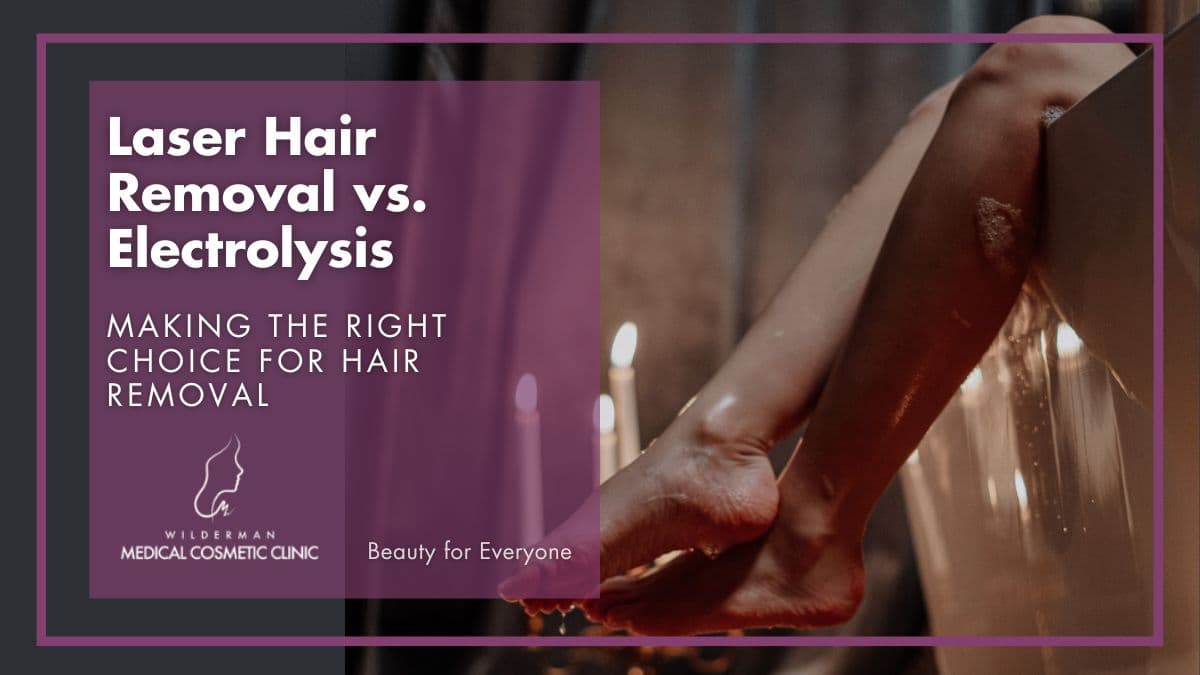Laser Hair Removal vs. Electrolysis
Making the Right Choice for Hair Removal
Unwanted hair can be a persistent issue for many individuals, leading them to seek effective and lasting solutions.
Two popular methods for hair removal, laser hair removal, and electrolysis, stand out as long-term solutions.

Get immediate answers to your questions about treatment options, costs, expected outcomes, and more.
- Expert Diagnosis
- Customized Treatment Plans
- No Obligation
- Comfort and Privacy
- Immediate Answers
Each method comes with its own set of benefits, risks, side effects, duration of results, drawbacks, and aftercare requirements.
In this blog post, we’ll delve into the details of both laser hair removal and electrolysis to help you make an informed decision about which option suits you best.
Laser Hair Removal: What is it?
Laser hair removal is a non-invasive procedure that uses concentrated light energy to target and destroy hair follicles. The process involves using a handheld device that emits a laser beam, which is absorbed by the pigment in the hair follicles.
This damages the follicles, inhibiting future hair growth.
Benefits
- Speed: Laser hair removal is relatively quick and can cover larger treatment areas in a shorter amount of time.
- Long-lasting results: Many individuals experience significant hair reduction that can last for months to years.
- Minimal discomfort: Most patients report mild discomfort during treatment, often likened to a rubber band snap on the skin.
- Convenience: Laser hair removal is less time-consuming than traditional methods like shaving and waxing.
- Versatile application: Suitable for face and body treatments, offering comprehensive coverage.
- Swift recovery: Minimal downtime means you can quickly return to your routine.
- Enhanced skin texture: Enjoy smoother, softer skin alongside hair reduction.
Risks and Side Effects
- Temporary Discomfort: Some redness, swelling, irritation, and mild discomfort might occur after the procedure, but these effects are usually short-lived.
- Changes in Skin Pigmentation: Rarely, changes in skin pigment can occur, particularly in individuals with darker skin tones. This risk can be minimized with proper equipment and experienced practitioners.
- Other Rare Complications: If not done properly, there is a risk of burns, blisters, and scars which can be minimized by choosing experienced practitioners.
Duration of Results
Laser hair removal results vary from person to person, but many individuals experience a significant reduction in hair growth that can last for several months to years.
Maintenance sessions may be needed over time to maintain optimal results.
Drawbacks
- Limited effectiveness on lighter hair: Laser hair removal works best on individuals with darker hair and lighter skin, as the laser targets the contrast between hair color and skin tone.
- Multiple sessions required: Achieving optimal results typically requires multiple sessions spaced several weeks apart.
Aftercare
- Sun protection: Protect treated areas from sun exposure to prevent complications.
- Avoid irritation: Refrain from activities that might irritate treated skin, such as hot showers or vigorous scrubbing.
- Gentle skincare: Use gentle skincare products and avoid harsh exfoliation for a few days.
- Cool compress: Applying a cool compress can help alleviate any temporary discomfort.
- Follow post-treatment guidelines: Follow any other post-treatment guidelines provided by your technician.
Electrolysis: What is it?
Electrolysis is a method that uses an electric current to destroy individual hair follicles. A tiny probe is inserted into the hair follicle, and the electric current damages the follicle’s ability to regrow hair.
Benefits
- Permanent results: Electrolysis is considered a permanent hair removal method, meaning treated hairs won’t regrow.
- Versatility: Electrolysis is suitable for all skin tones and hair colors, making it a viable option for everyone.
- Precision: It targets individual hair follicles with precision, making it effective for small and delicate areas.
Risks and Side Effects
- Discomfort: The process can be more uncomfortable than laser hair removal, with sensations often described as a stinging or pricking feeling.
- Redness and Swelling: Temporary redness and swelling are common immediately after treatment.
- Invasive: Since electrolysis is an invasive procedure, there is a possibility of infection occurring.
- Possible scarring: In rare cases, scarring may occur if the procedure is not performed correctly. Therefore, it is important to choose a qualified professional.
Duration of Results
Electrolysis offers permanent hair removal results. However, since the procedure targets each hair follicle individually, multiple sessions are necessary to cover larger treatment areas.
Drawbacks
- Time-consuming: Electrolysis is a meticulous process that may require more time compared to laser hair removal, especially for larger areas.
- Pain: The procedure can be more uncomfortable compared to other methods.
Aftercare
- Avoid touching: Refrain from touching treated areas to minimize the risk of infection.
- Avoid sun exposure: Protect the treated area from the sun to prevent skin damage.
- Cleanse gently: Clean the treated area gently with a mild cleanser.
- Avoid makeup: Avoid using makeup on treated areas for at least a day.
- Follow Care Instructions: Adhere to aftercare instructions provided by your technician to avoid complications.
Differences Between Laser Hair Removal and Electrolysis
- Principle of Operation: Laser hair removal uses light energy to damage follicles by targeting pigment, inhibiting growth. Electrolysis destroys follicles individually with electric currents to prevent regrowth.
- Permanent Results: Laser hair removal offers varying but often long-lasting reductions in growth, sometimes requiring maintenance, while Electrolysis is for permanent hair removal, ensuring treated follicles don’t regrow hair.
- Suitability for Skin and Hair Types: Laser hair removal works best for individuals with fair skin and dark hair, while electrolysis is suitable for all skin tones and hair colors.
- Treatment Time: Laser hair removal covers larger areas quickly, making it efficient for larger body parts. Electrolysis is slower due to its precision-based approach, as each hair follicle is treated individually.
Similarities Between Laser Hair Removal and Electrolysis
- Professional Expertise: Both methods require skilled professionals to perform the procedures safely and effectively. Choosing a licensed and experienced practitioner is crucial for optimal results.
- Multiple Sessions: Both techniques need multiple sessions to achieve desired results. The number of sessions varies depending on factors such as hair type, skin tone, and treatment area.
- Safe and Effective: Both techniques are safe and FDA-approved for permanent hair removal, eradicating the necessity for shaving and waxing while averting ingrown hairs.
Takeaway
Choosing between laser hair removal and electrolysis depends on factors such as your hair color, skin type, pain tolerance, and desired level of permanence.
Laser hair removal offers a faster and less painful option for those with suitable skin and hair types, while electrolysis provides a permanent solution for all hair and skin types but requires more time and patience.
Ultimately, consulting with a trained professional can help you make an informed decision that aligns with your preferences and goals for hair removal.
Reference
Healthline. (Sep 13, 2018). Laser Hair Removal vs. Electrolysis: What’s the Difference? Retrieved from https://www.healthline.com/health/beauty-skin-care/laser-hair-removal-vs-electrolysis#electrolysis (Accessed Aug 28, 2023).
Westlake Dermatology. (Oct 15, 2021). Electrolysis vs. Laser Hair Removal. Retrieved from https://www.westlakedermatology.com/blog/electrolysis-vs-laser-hair-removal/ (Accessed [Access Date]).
LaserAll Clinic. (Jan 20, 2020). Electrolysis versus Laser Hair Removal. Retrieved from https://laserallclinic.com/electrolysis-versus-laser-hair-removal/ (Accessed [Access Date]).
LiveHealthily. (May 17, 2022). Laser Hair Removal vs. Electrolysis: What’s the Difference? Retrieved from https://www.livehealthily.com/self-care/laser-hair-removal-electrolysis (Accessed [Access Date]).
Related content that may be of interest
Laser Hair Removal Treatment – Unwanted body hair is a concern for many individuals. While various temporary hair removal methods exist, such as shaving, waxing, and threading, they often come with their fair share of hassle and discomfort. Laser hair removal, a revolutionary treatment, offers a long-term solution to unwanted hair growth. Laser hair removal treatment is one such way to remove unwanted hair. It is considered to be one of the most …
Laser hair removal: Are you a good candidate? – Frequently, women begin experimenting with different methods of removing unwanted body and facial hair in elementary school. While some ladies prefer to shave or wax areas like their legs and underarms, others use products like depilatory creams. However, all of these undesirable hair removal techniques have the same thing in common: they are all …
Stay Ahead of the Beauty Curve
Beyond Beauty: Elevate Your Routine with Insider Tips and Breakthroughs – Subscribe Now!
Transform your beauty routine into something extraordinary!






